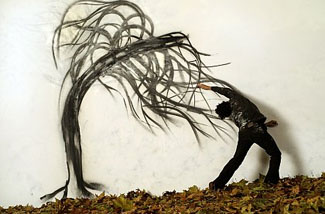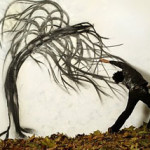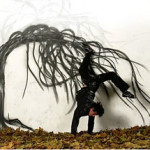By JOHN RUGGIERI
Robin Rhode’s video performance The Storyteller, involves a lone performer whose storyline is enlivened in expressively drawn wall and ground illustrations using time-exposed action and simple props. It is the seemingly bare production values and materials that are at first intriguing to me upon viewing this performance-based work.
Much of the work in his three-gallery exhibition succeeds on its dynamic, formal tug of art completing life, multiple exposures of daily acts and tasks created by a three-dimensional performer interacting with two-dimensional materials.
In his photographs, the iconic act of drawing on pavement using a thick white chalk outline to document a murder scene is challenged and softened here. (Rhode uses outright transgression and irony in previous performances such as Car Theft.) The performer seems unsettled with his banal, dusty surroundings and, armed only with chalk and something to wash it off occasionally, constructs light, living dreams from the everyday.
What would otherwise be mundane tasks and sweat-soaked athletics are transformed into ecstatic similes of the real world. Here a small scrawled boat being pulled fictionally up a real flight of concrete stairs, there a man lying on the street playing the role of circus acrobat hoisted high in the air on rope and rings, the props and action drawn on the street.
A few works that I was able to see seem to employ what the gallery’s press release describes as “key thematic elements such as racism and identity” for this native South African artist. Rushing to take in his video work a second time, I missed the third gallery of Rhode’s sculpture of a more political nature on the closing day of the exhibition.
Two photographs I did see can be interpreted to reference these more earthbound, contemporary issues. “Juggla” portrays a circus juggler, adorned in top hat, formal jacket, and scruffy street pants, and a scrawled and washed away sequence of balls in the rendered “air.” “Blackhead” is a slightly disturbing but ever-playful sequence of a black blob of a head being scrawled and washed repeatedly on a wall while “attached” to the performer’s body.
Does Rhode position real history from his homeland into his solo performances? Might his figurative dramas be seen as one-acts about struggle, justice, healing? What appears to be ingeniously simple pantomime may very well be a complex commentary on minstrels, lynching, perhaps even blackface – from a quick read. But I can only guess here, using my overly political, burning eyes, trained well to exhaustively find the sociopolitical.
I find Rhode’s magic more interesting than trying to dissect any political plays he may have in mind, at least in the work I was able to see. Rhode also uses literal forms for sublime, almost abstract ends. Watching the video performance The Storyteller, at first I was awe-struck by the dancer’s enthralling, acrobatic leaps and bounds, amazed if Rhode were doubly talented enough to be dancing, too. He is not the performer here and collaborated on the movement with the professional dancer Jean-Baptiste André in Rheims, France and scored to the modern, dramatic music of violin/cellist Didier Petit.
Another invisible force in The Storyteller is one that joins the movement of the dancer with the whirling technology of the background. His upwardly jutting arms reminded me of gospel choirs and the contemporary joy in Mark Morris pieces set to Mozart. The most poetic moment, which could easily be seen as a sentimental gesture with less sophisticated choreography, was the dancer’s “sawing” the animated tree into an abstract jungle of swirling lines continually growing in the background.
Robin Rhode’s forging of streetwise, technological, and metaphysical magic with political irony and passion is a rare and delightful feat.
- Robin Rhode, stills from The Storyteller, 16 mm transferred to video, 2006
"Robin Rhode: The Storyteller" was on view until June 23rd at Perry Rubenstein Gallery located at 526 West 24th St in New York.
All images are courtesy of the artist and Perry Rubenstein Gallery






